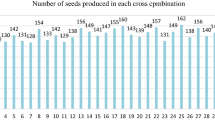Abstract
Tritordeums (Tritordeum Ascherson et Graebner) are the amphiploids derived from the crosses between Hordeum chilense and durum or bread wheats. Primary tritordeums are obtained using H. chilense as female parent and therefore they exhibit H. chilense cytoplasm. The effect of wheat cytoplasm on agronomic performance of tritordeums was investigated. We developed four pairs of reciprocal F1 lines only differing in their cytoplasm, donated from wheat or H. chilense alternatively. The agronomic performance of reciprocal F1 lines contrasting for their cytoplasm was evaluated. The following traits were assessed: leave and tillers number one month after sowing, plant height, anthesis date, total number of ears, number of spikelets per spike, fertility of the main spike, length and wide of the flag leaf in the main stem and thousand kernel weight. Reciprocal F1 lines did not differ for any of the agronomic traits evaluated with the exception of anthesis date in the pair THC1726/HTC1727. Therefore, both wheat and H. chilense cytoplasms can be used in tritordeum breeding.
Similar content being viewed by others
References
FAOSTAT, http://Apps.Fao.Org, 2004.
FAO, The State of the World’s Plant Genetic Resources for Food and Agriculture, Rome, 1997.
Martin, A., Martínez, C., Rubiales, D., and Ballesteros, J., Tritordeum: Triticale’s New Brother Cereal Triticale: Today and Tomorrow, Dordrecht, 1996, pp. 57–72.
Atienza, S.G., Gimenez, M.J., Martin, A., and Martin, L.M., Variability in Monomeric Prolamins in Hordeum chilense, Theor. Appl. Genet., 2000, vol. 101, pp. 970–976.
Atienza, S.G., Alvarez, J.B., Villegas, A.M., et al., Variation for the Low-Molecular-Weight Glutenin Subunits in a Collection of Hordeum chilense, Euphytica, 2002, vol. 128, pp. 269–277.
Atienza, S.G., Satovic, Z., Martin, A., and Martin, L.M., Genetic Diversity in Hordeum chilense Roem. et Schult. Germplasm Collection as Determined by Endosperm Storage Proteins, Genet. Res. Crop Evol., 2005, vol. 52, pp. 127–135.
Martin, A. and Cabrera, A., Cytogenetics of Hordeum chilense: Current Status and Considerations with Reference to Breeding, Cytogenet. Genome Res., 2005, vol. 109, pp. 378–384.
Atienza, S.G., Ramírez, M.C., Hernández, P., and Martín, A., Chromosomal Location of Genes for Carotenoid Pigments in Hordeum chilense, Plant Breed., 2004, vol. 123, pp. 303–304.
Bothmer, R.V. and Jacobsen, N., Interspecific Crosses in Hordeum (Poaceae), Pl. Syst. Evol., 1986, vol. 153, pp. 49–64.
Martin, A., Martin, L.M., Cabrera, A., et al., The Potential of Hordeum chilense in Breeding Triticeae Species (Triticeae Iii), Enfield, CT, 1998, pp. 377–386.
Martin, A. and Chapman, V., A Hybrid between Hordeum chilense and Triticum aestivum, Cereal Res. Communs., 1977, vol. 5, pp. 365–368.
Martin, A. and Laguna, E.S., Cytology and Morphology of the Amphiploid Hordeum chilense × Triticum turgidum Conv durum, Euphytica, 1982, vol. 31, pp. 261–267.
Martin, A., Alvarez, J.B., Martin, L.M., et al., The Development of Tritordeum: A Novel Cereal for Food Processing, J. Cereal Sci., 1999, vol. 30, pp. 85–95.
Shonnard, G.C. and Gepts, P., Genetics of Heat Tolerance during Reproductive Development in Common Bean, Crop. Sci., 1994, vol. 34, pp. 1168–1175.
Matsui, K., Yoshida, M., Ban, T., et al., Role of Male-Sterile Cytoplasm in Resistance to Barley Yellow Mosaic Virus and Fusarium Head Blight in Barley, Plant Breed., 2002, vol. 121, pp. 237–240.
Zhang, A., Yu, F., and Zhang, F., Alien Cytoplasm Effects on Phytosiderophore Release in Two Spring Wheats (Triticum aestivum L.), Genet. Res. Crop Evol., 2003, vol. 50, pp. 767–772.
Hernández, P., Barcelo, P., Martin, A., and Cabrera, A., The Effect of Hordeum chilense and Triticum cytoplasm on Anther Culture Response of Tritordeum, Plant Cell Rep., 2001, vol. 20, pp. 542–546
Allen, J.O., Effect of Teosinte Cytoplasmic Genomes on Maize Phenotype, Genetics, 2005, vol. 169, pp. 863–880.
Tsunewaki, K., Wang, G.-Z., and Matsuoka, Y., Plasmon Analysis of Triticum (Wheat) and Aegilops: 1. Production of Alloplasmic Common Wheat and Their Fertilities, Genes Genet. Syst., 1996, vol. 71, pp. 293–311.
Tsunewaki, K., Wang, G.-Z., and Matsuoka, Y., Plasmon Analysis of Triticum (Wheat) and Aegilops: 2. Characterization and Classification of 47 Plasmon Based on Their Effects on Common Wheat Phenotype, Genes Genet. Syst., 2002, vol. 77, pp. 409–427.
Fukasawa, H., Nucleus Substitution and Restoration by Means of Successive Backcrosses in Wheat and Its Related Genus Aegilops, Japan. J. Bot., 1959, vol. 17, pp. 55–91
Soliman, K., Fedak, G., and Allard, R.W., Inheritance of Organelle DNA in Barley and Hordeum × Secale Intergeneric Hybrids, Genome, 1987, vol. 29, pp. 867–872.
Laser, B., Mohr, S., Odenbach, W., et al., Parental and Novel Copies of the Mitochondrial Orf25 Gene in the Hybrid Crop-Plant Triticale: Predominant Transcriptional Expression of the Maternal Gene Copy, Curr. Genet., 1997, vol. 32, pp. 337–347.
Aksyonova, E., Sinyavskaya, M., Danilenko, N., et al., Heteroplasmy and Paternally Oriented Shift of the Organellar DNA Composition in Barley-Wheat Hybrids during Backcrosses with Wheat Parents, Genome, 2005, vol. 48, pp. 761–769.
Foley, M.E. and Fennimore, S.A., Genetic Basis for Seed Dormancy, Seed Sci. Res., 1998, vol. 8, pp. 173–182.
Hirschberg, J., Carotenoid Biosynthesis in Flowering Plants, Curr. Opin. Plant Biol., 2001, vol. 4, pp. 210–218.
Author information
Authors and Affiliations
Corresponding author
Additional information
The text was submitted by the authors in English.
Rights and permissions
About this article
Cite this article
Atienza, S.G., Ramírez, M.C., Martín, A. et al. Effects of reciprocal crosses on agronomic performance of tritordeum. Russ J Genet 43, 865–868 (2007). https://doi.org/10.1134/S1022795407080054
Received:
Issue Date:
DOI: https://doi.org/10.1134/S1022795407080054




